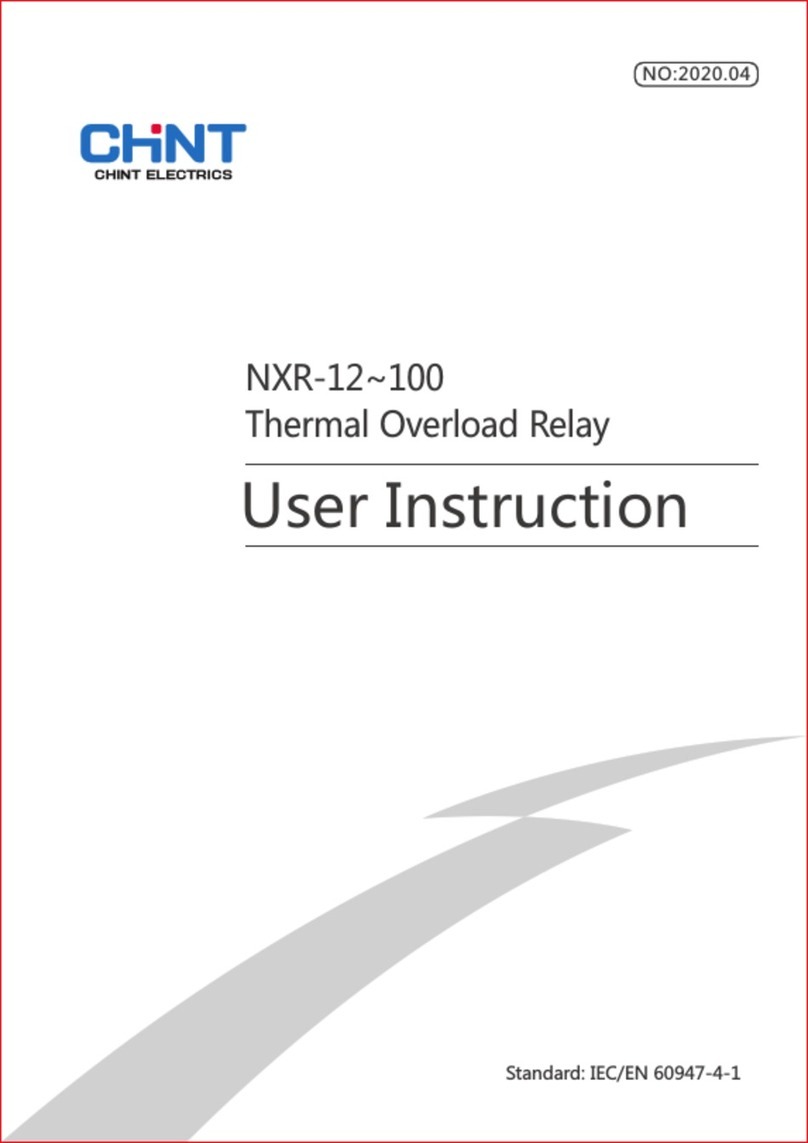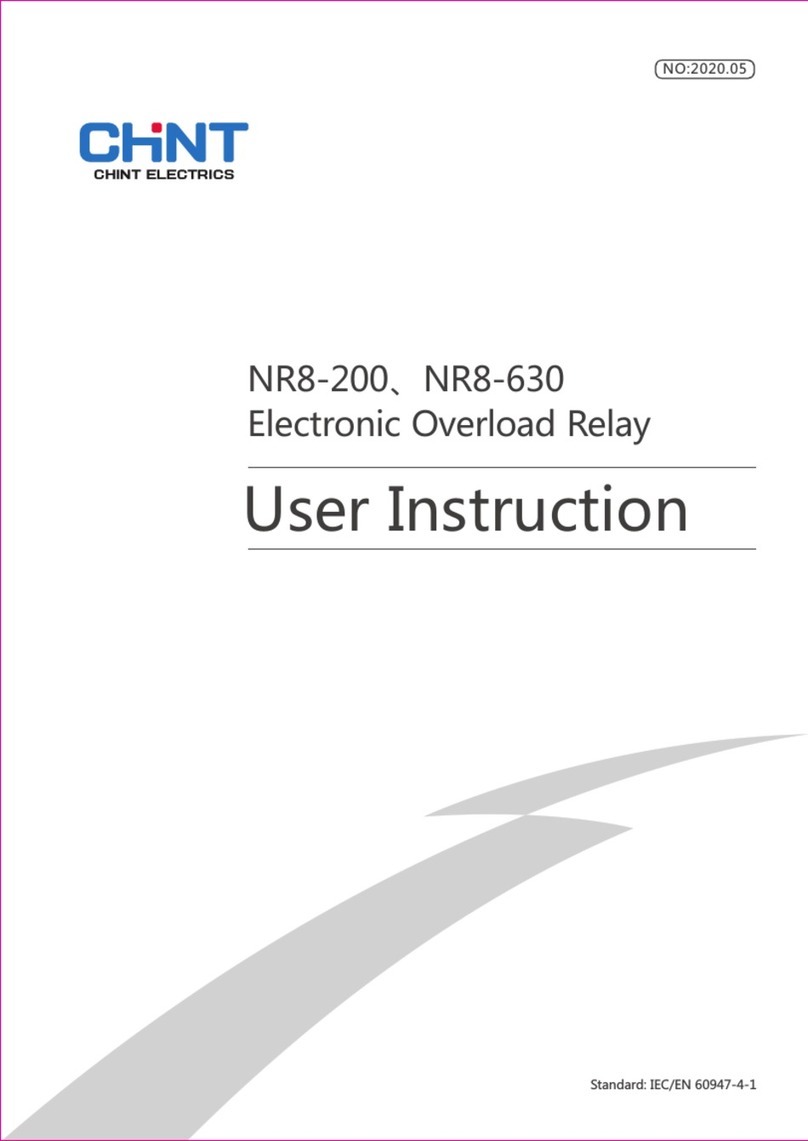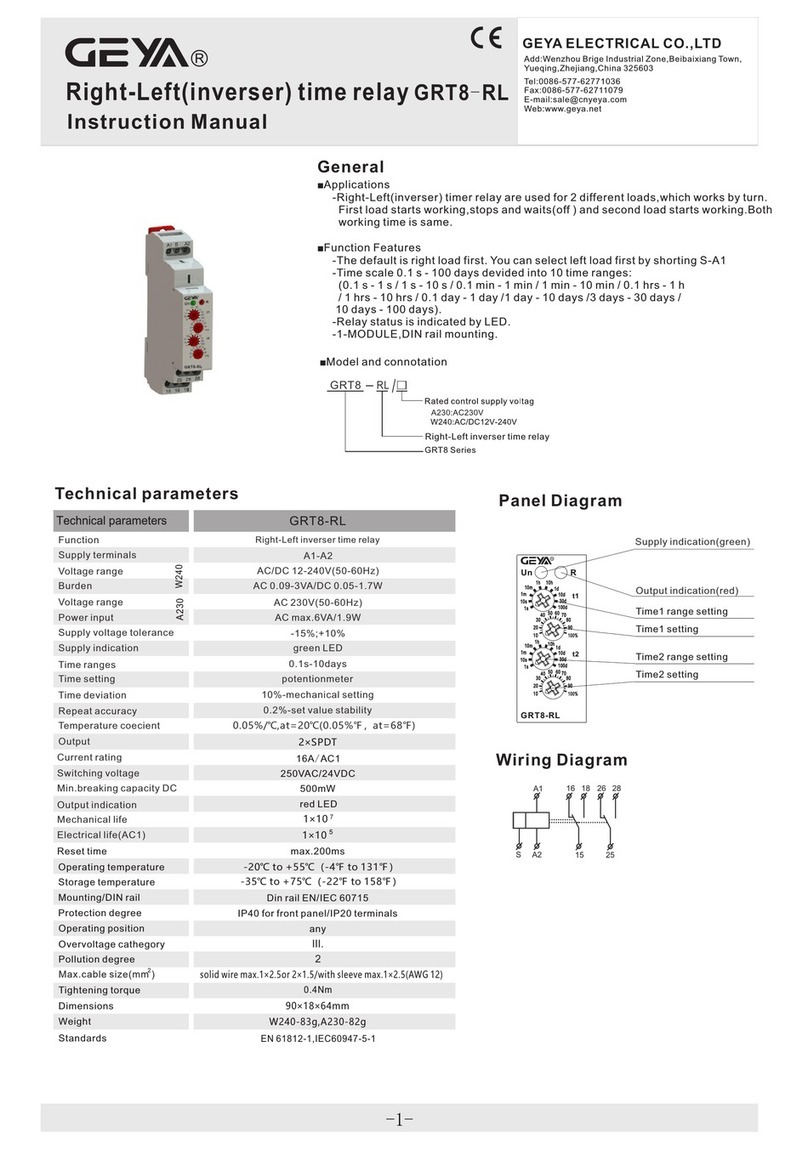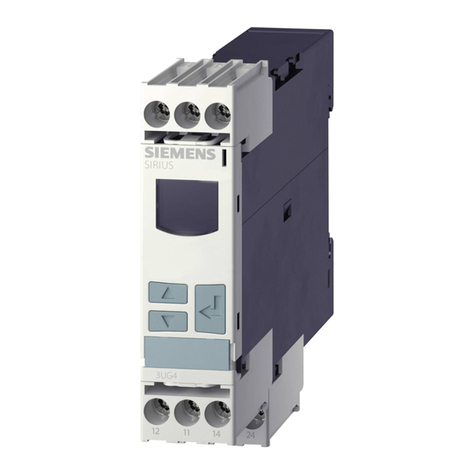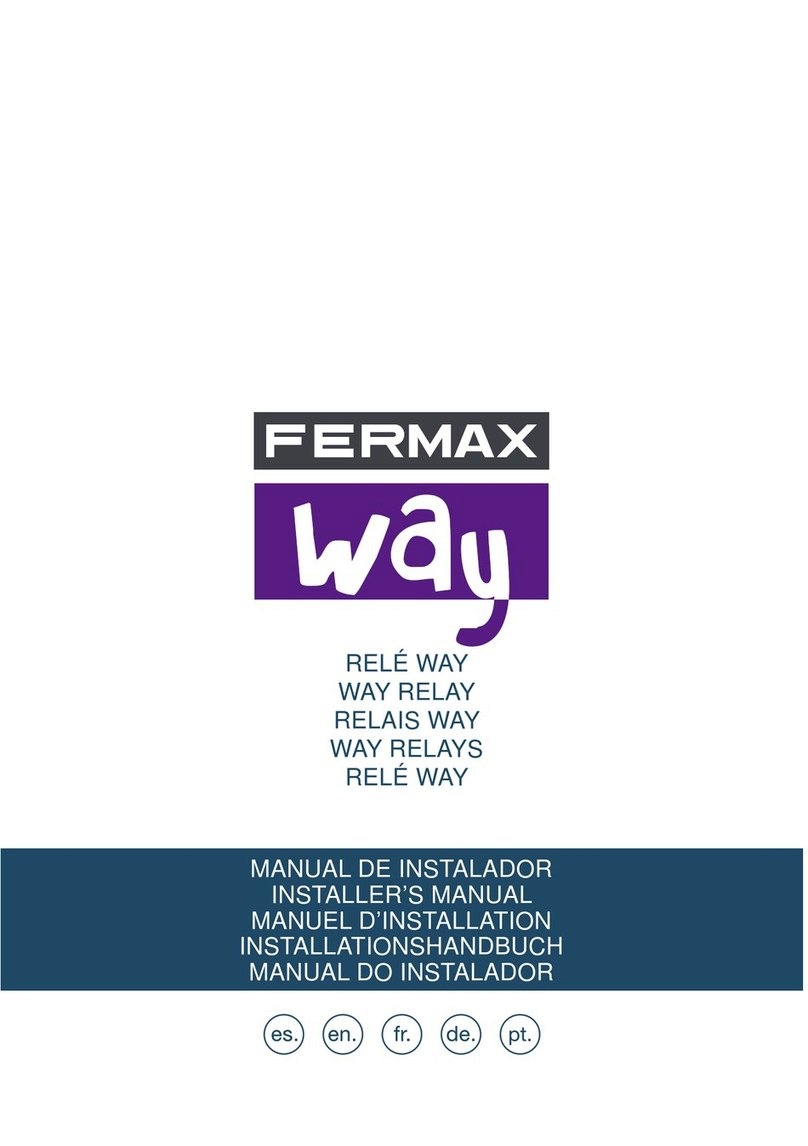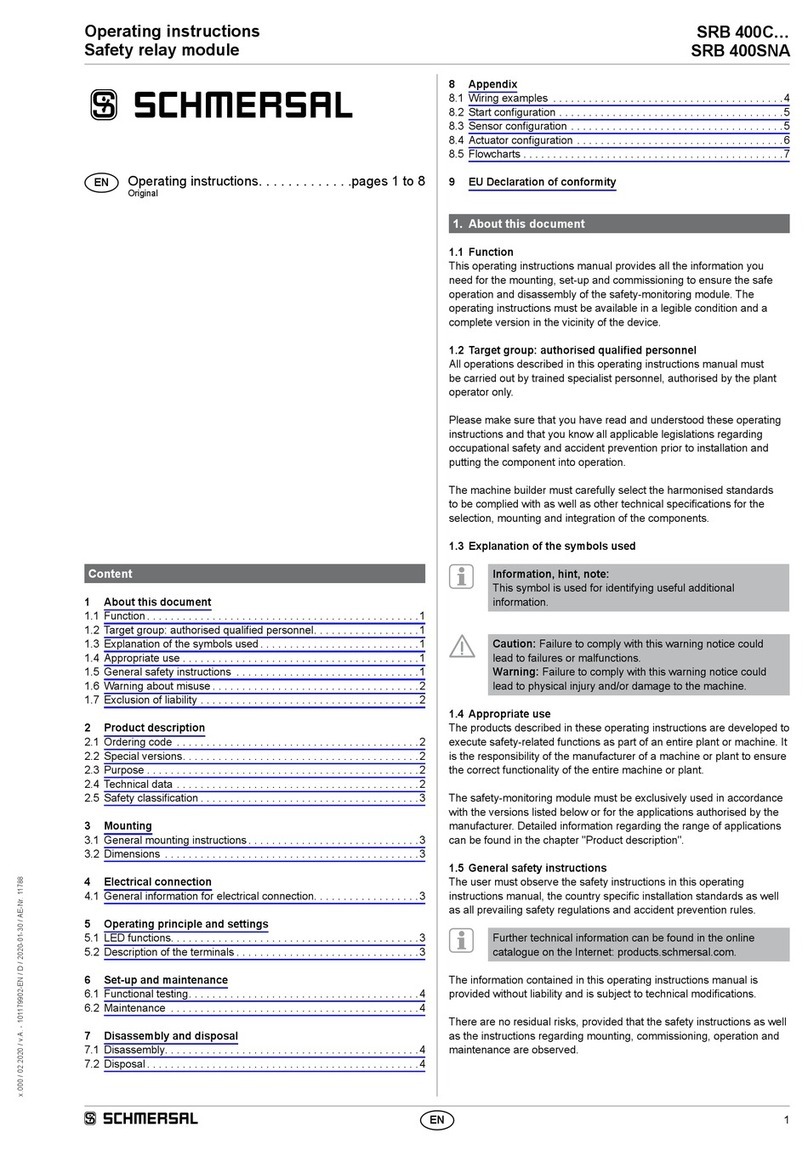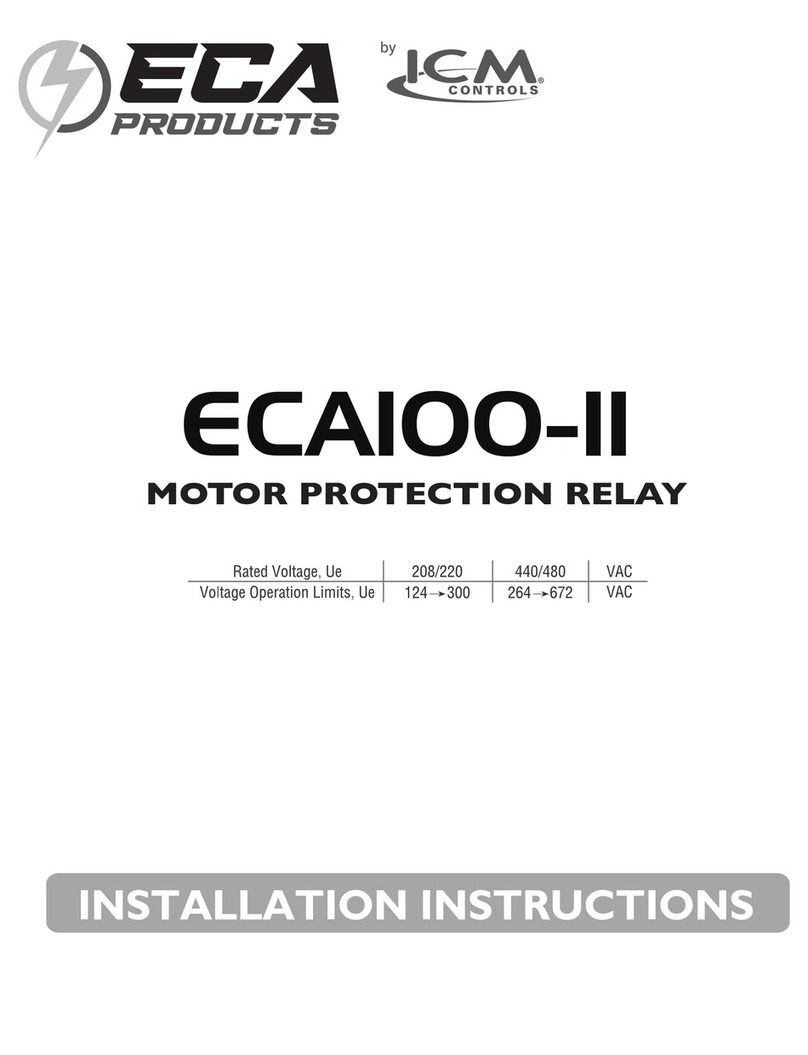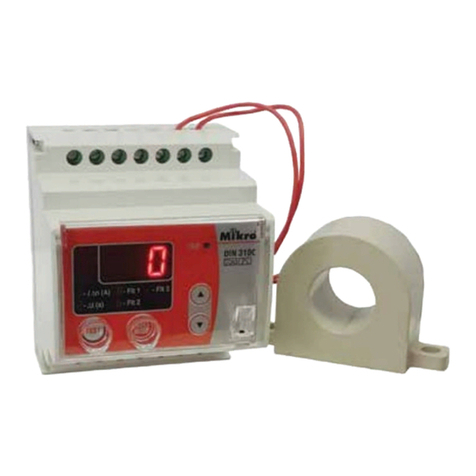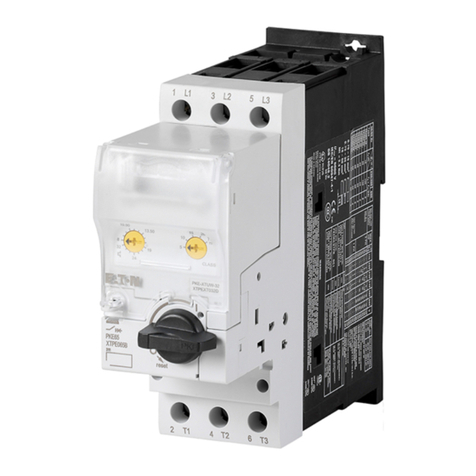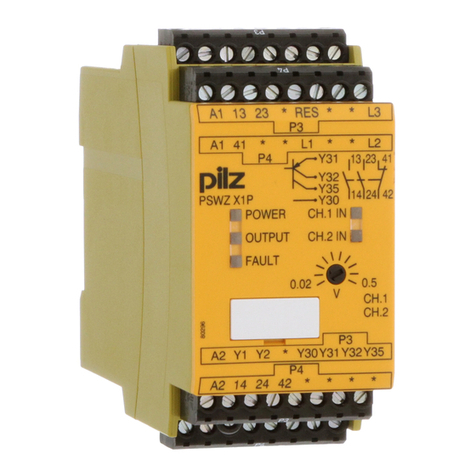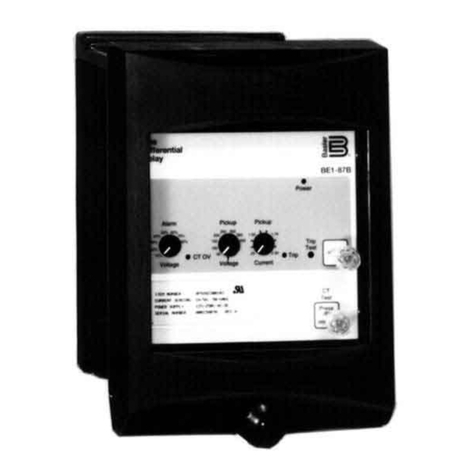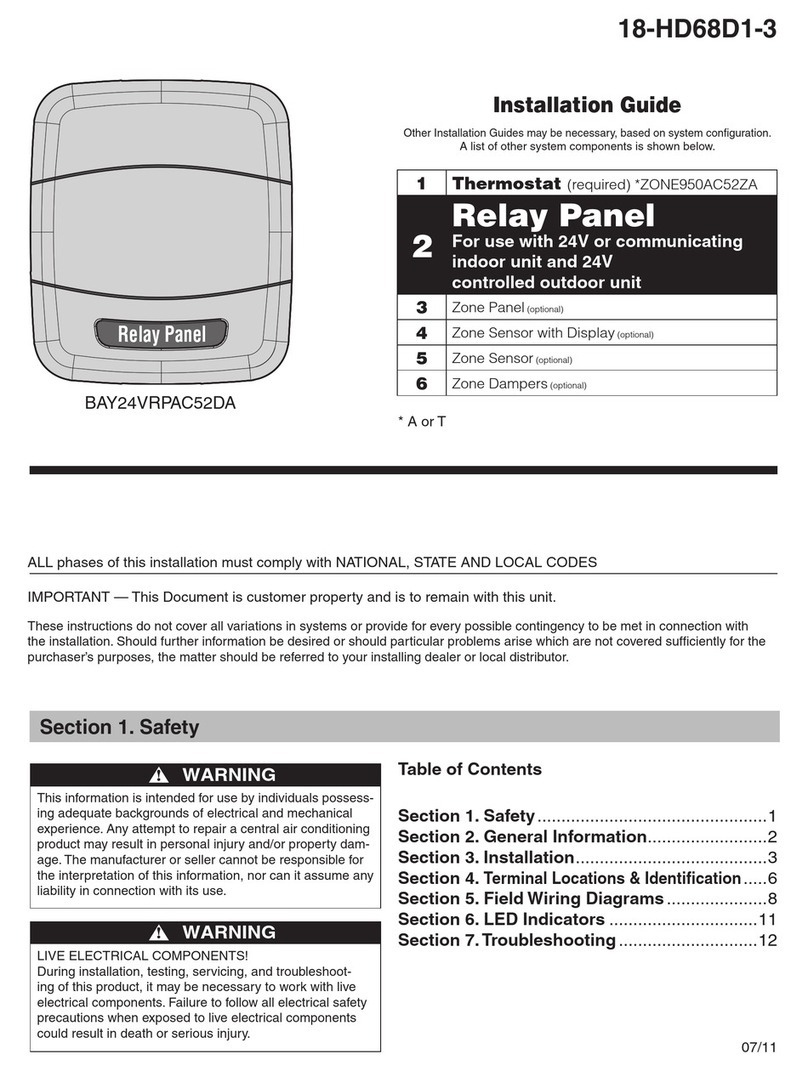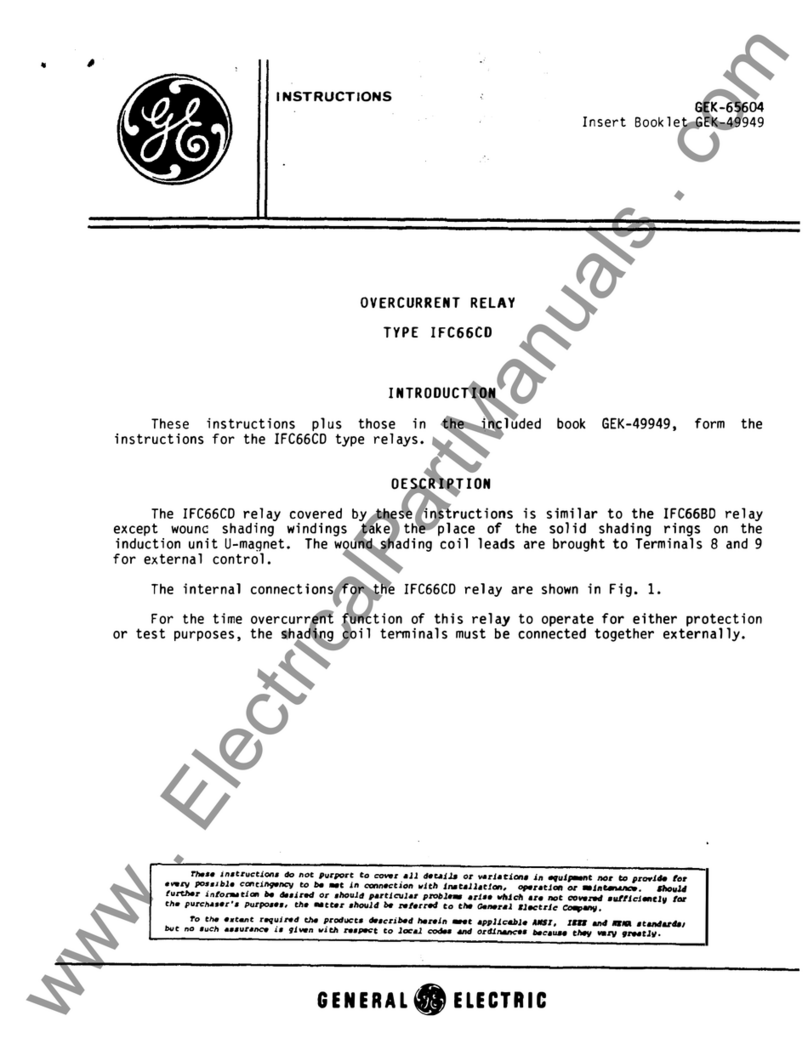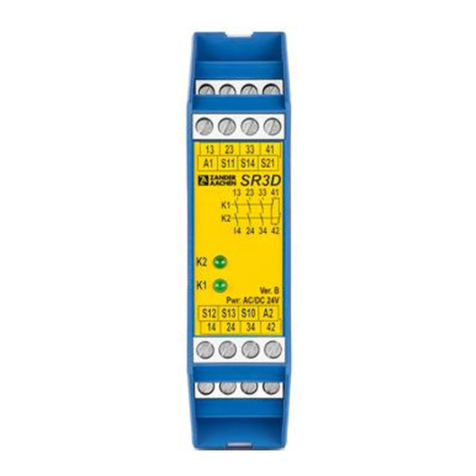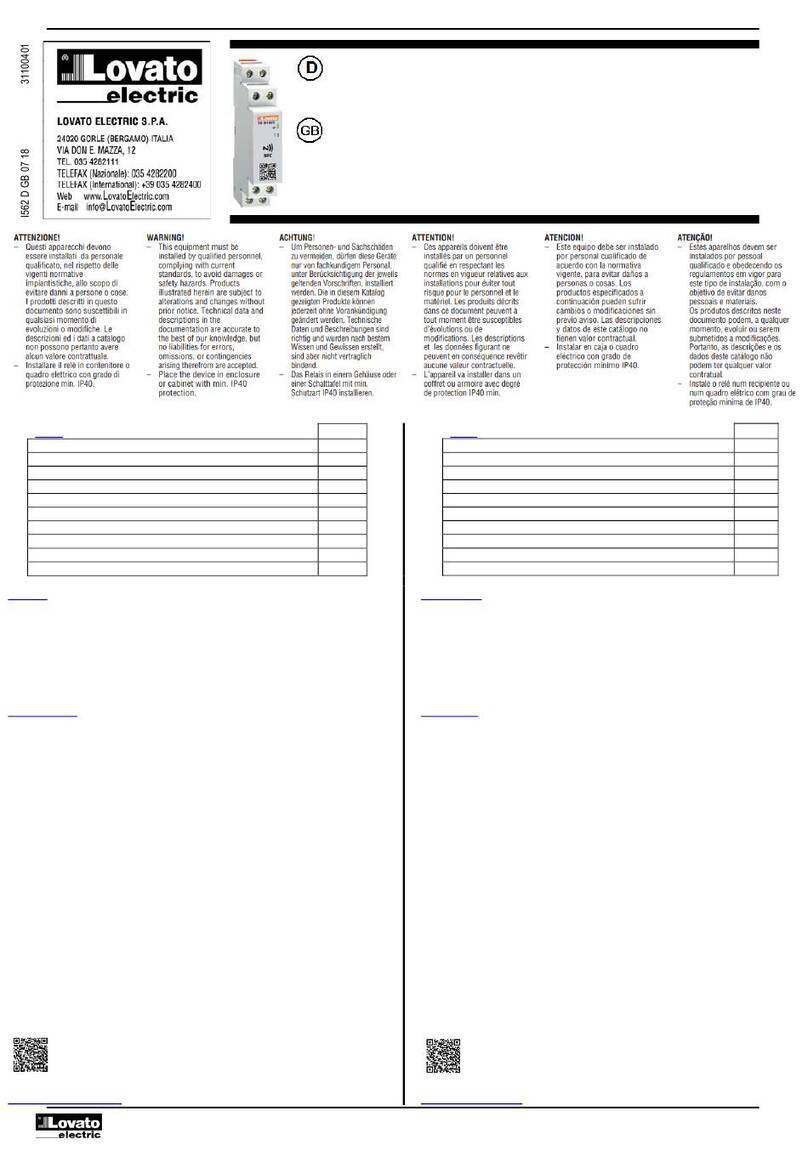CHINT NR2 Series Installation instructions

NO:2020.04
Standard: IEC/EN 60947-4-1
NR2 Series
Thermal Overload Relay
User Instruction

Only professional technicians are allowed for installation and
maintenance.
Installation in any damp, condensed-phase environment with
inflammable and explosive gas is forbidden.
When the product is being installed or maintained, the power
must be switched off.
You are prohibited from touching the conductive part when the
product is operating.
1
2
3
4
Safety Warning

01
Use Purpose
1
NR2 series thermal overload relay (hereinafter referred to as thermal
relay) is applicable to circuits with frequency of AC 50Hz or 60Hz, rated
operating voltage up to 690V and current from 0.1A to 630A. It is used for
overload protection and phase-failure protection of 3-phase AC motor. It
can also be used with corresponding contactor to act as magnetic starter.
Main Technical Parameters
2
Table 1 Environmental conditions and
technical parameter of main circuit
Environmental conditions
Ambient temp. (℃)
Hot and humid
atmospheric conditions
-5℃~+40℃, average temperature should not
exceed +35℃ within 24h
Relative humidity should not exceed 50% at
+40℃; up to 90% at +20℃
Pollution class/installation category
Altitude No influence below 2000m
Class 3/Ⅲ
Table 2 Key technical parameters
Model
Phase-failure protection
Manual and automatic reset
Temperature compensation
Tripping indication
Test button
Stop button
Setting current range (A)
Matching mounting base
Rated insulation voltage Ui
NR2-
11.5
NR2-
25
NR2-
36
NR2-
93
NR2-
150
NR2-
200
NR2-
630
Yes
Yes
Yes
Yes
Yes
Yes
0.1-13
MB-1
Yes
Yes
Yes
Yes
Yes
Yes
0.1-25
MB-2
Yes
Yes
Yes
Yes
Yes
Yes
23-36
MB-3
Yes
Yes
Yes
Yes
Yes
Yes
23-93
MB-4
Yes
Yes
Yes
Yes
Yes
Yes
80-150
—
Yes
Yes
Yes
Yes
Yes
Yes
80-200
—
Yes
Yes
Yes
Yes
Yes
Yes
160-630
—
690V

02
Table 3 Combination with contactor and fuse
Rated operating voltage Ue
Rated impulse withstand voltage Uimp
690V
6kV
5A
220V/2.73A ; 380V/1.58A
220V 0.2A
1NO 1NC
6A
Model NR2-
11.5
NR2-
25
NR2-
36
NR2-
93
NR2-
150
NR2-
200
NR2-
630
Auxiliary circuit
Ith
AC-15
DC-13
Auxiliary contact type
Specification of
matching fuse A
NR2-11.5
Model
Setting
current
range A
Specification of
matching fuse gG
(Recommend RT16) A
Recommended
matching
contactor
Sectional area
of connecting
wire mm²
0.1~0.16
0.16~0.25
0.25~0.4
0.4~0.63
0.63~1
1~1.6
1.25~2
1.6~2.5
2.5~4
4~6
5.5~8
7~10
9~13
2
2
2
2
4
4
6
6
10
16
20
20
25
1.5
2.5
NC6-09
1
Table 2 (continued)

03
NR2-25
Model
Setting
current
range A
Specification of
matching fuse gG
(Recommend RT16) A
Recommended
matching
contactor
Sectional area
of connecting
wire mm²
0.1~0.16
0.16~0.25
0.25~0.4
0.4~0.63
0.63~1
1~1.6
1.25~2
1.6~2.5
2.5~4
4~6
5.5~8
7~10
9~13
12~18
17~25
23~32
28~36
23~32
30~40
37~50
48~65
55~70
63~80
80~93
2
2
2
2
4
4
6
6
10
16
20
20
25
35
50
63
80
63
100
100
100
125
125
160
NC1/CJX2-09
NC1/CJX2-12
NC1/CJX2-18
NC1/CJX2-25
NC1/CJX2-32
NC7-09~22
NC7-25~32
1
1
1
1
1
1
1
1
1
1
1
1.5
2.5
2.5
4
6
10
6
10
10
16
25
25
35
NR2-36
NR2-93
NC1/CJX2-32
NC7-32~38
NC1/CJX2-40
NC1/CJX2-50
NC1/CJX2-65
NC1/CJX2-80
NC1/CJX2-95
NC7-40~65
NC7-80~95
Table 3 (continued)

04
NR2-150
(match
with NC2
type)
NR2-150
(match
with NC7
type)
NR2-200
Model
Setting
current
range A
Specification of
matching fuse gG
(Recommend RT16) A
Recommended
matching
contactor
Sectional area
of connecting
wire mm²
80~104
95~120
110~150
80~104
95~120
110~150
80~125
100~160
125~200
160~250
200~315
250~400
315~500
400~630
250
250
250
250
250
250
200
250
315
400
500
630
800
800
NC2-115, 150
NC7-115,
150, 170
NC2-115, 150,
185, 225
NC7-115, 150,
170, 205
35
50
50
35
50
50
50
70
95
120
185
240
2×150
2×185
NC2-185, 225,
265, 330, 400,
500, 630
NC7-205, 250,
300, 410, 475,
620
NR2-630
Table 3 (continued)

05
Figure 1 Thermal relay operation time – current characteristic curve
S
1
2
4
6
8
10
20
40
1
2
4
6
8
10
20
40
60
80
100
120
0.8 1 1.2 1.5 2 3 4 5 6 7 8 9 10
min
heat state
3 phase
2 phase
cold state
2 phase
3 phase
Amplification factor of setting current

06
Installation
3
1 Installation)
C
H
A
NO NC
98 97 96 95
2 T1 4 T2 6 T3
STOP RESET
TEST
A
B
Figure 2 Product overall dimensions (NR2-11.5~150)
D
G
E
35
F
Figure 3 Outline dimensions of
product with mounting base (NR2-11.5~93)
H

07
Am ax Bmax Cmax E H
FGD
Table 4 Overall dimensions
Model
NR2-11.5
NR2-25
NR2-36
NR2-93
NR2-150 (match
with NC2 type)
NR2-150 (match
with NC7 type)
45
45
55
72
102
98
75
66
78
83
141
135
67.5
94
94
117
120
120
45
45
55
72
96
93.6
102.9
126.5
75.3
102
102
126
34
35
41
61.5
85.1
55
75.1
109
Must combined with contactor
10 9±0.4
160
20 40±0.2
56
M8
181
81
126
40 40
8
Figure 4 Overall dimensions of NR2-200
Unit:mm
Unit:mm

08
215
12
M10
25/30* 48±0.2
Figure 5 Dimensions of NR2-630
Note: Dimensions marked with “*” means specifications for 400A and below/
specifications for 400A and above
Figure 6 Assembly drawing of thermal relay and contactor
44/45*
115 171
48/55* 48/55*
180/194*
130±0.4
Unit:mm

09
Main
circuit
M10 20N.m
M8 10N.m
M10
10N.m
M10
10N.m
M4
1.7N.m
M3.5
1.2N.m
M3.5
0.8 N.m
Wrench
NR2-630
NR2-200
NR2-150
NR2-93
NR2-36
NR2-25
NR2-11.5
NR2-11.5
~630
2
S(mm )
120~2×
185
50~95
35~5035~50
4~35 4~35
4~10 4~10 4~10 4~10 A>4mm,
L<12mm
A>4mm,
L<10mm
1~6 1~6 1~6 1~6 1~6 1~6
1~2.5 1~2.5 1~2.5 1~2.5 1~2.5 1~2.5A>3.5mm,
L<9mm
1~2.5 1~2.5 1~2.5 1~2.5 1~2.5 1~2.5
2
mm 2
mm 2
mm 2
mm 2
mm 2
mm A>3.5mm,L<8mm
Table 5 Wiring parameters
Auxiliar y
circuit

10
Maintenance
4
Conduct product test and maintenance every half a year to ensure the
smooth operation of the product and the good contact of NO and NC
contacts. Tighten the terminal screws with specified torque and align the
protection capability of the thermal overload relay with load according to
commissioning requirements.
Be careful when handling and installing the thermal relay. It is
prohibited to move the product by crane with strong impact so that the
product will not be damaged and its protection characteristics will not
change.
2) Operation and commissioning
Stop
Figure 7 Operation diagram
Reset
Test
Operation indication
adjustable current range
Automatic reset Manual reset

11
Table 6 Analysis and Troubleshooting of Fault
Symptoms Cause analysis Troubleshooting method and precautions
Misoperation
of thermal
relay without
the motor
being
overloaded.
Thermal relay
does not
operate.
Size is too small. Change to product with bigger size.
The set current value is
smaller than the actual
operating current of the
motor.
Fine tune the cam clockwise so that the set
current matches the actual motor current.
Check installation status and conduct
troubleshooting. Do not place the product
in environment with strong shock or
vibration.
Stong shock or vibration
Frequent start of motor The start frequency of motor should not
exceed 30 times per hour.
The sectional area of
connecting wire is too
small, or there is loose
connection.
Use standard wire and torque.
The size is too big. Change to product with smaller size.
The set current value is
bigger than the actual
operating current of the
motor.
Fine tune the cam counter-clockwise so
that the set current matches the actual
motor current.
The sectional area of
connecting wire is too
big.
Use standard wire and torque.
Thermal
relay does
not work.
The product is not reset. Press the reset button to reset the relay.
Auxiliary contacts are
not powered-on.
Main circuit or auxiliary
circuit is burnt
Replace thermal relay.
Replace thermal relay.

12
Environmental Protection
5
In order to protect the environment, the product or product parts
should be disposed of according to the industrial waste treatment process,
or be sent to the recycling station for assortment, dismantling and recycling
according to local regulations.

QC PASS
Test date: Please see the packing
ZHEJIANG CHINT ELECTRICS CO.,LTD.
NR2 Series
Thermal Overload Relay
IEC/EN 60947-4-1
Check 22
13

NR2 Series
Thermal Overload Relay
User Instruction
Zhejiang Chint Electrics Co., Ltd.
Add: No.1, CHINT Road, CHINT Industrial Zone,North Baixiang,
Yueqing, Zhejiang 325603,P.R.China
E-mail: global-sales@chint.com
Website: http://en.chint.com
This manual suits for next models
7
Table of contents
Other CHINT Relay manuals
